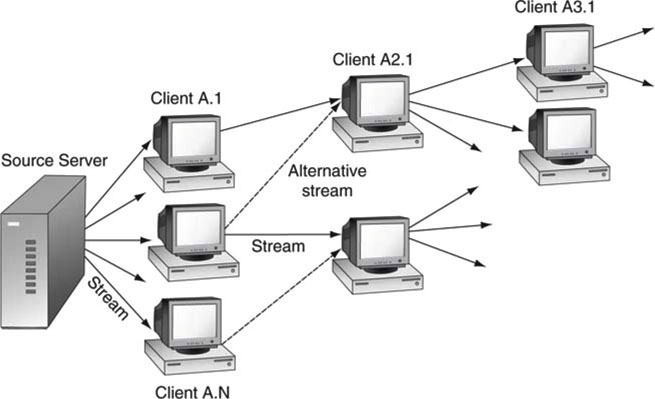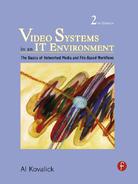Appendix I: Is It Rabbits Multiplying or Is It Streaming?
Inventors have dreamed up all manner of methods to stream content. One novel approach is based on a mesh of peer-to-peer connections. The idea centers on distributing the master stream from the source to only a few clients and not the entire population, as is normally the case. Each client (e.g., a PC viewing or listening station) functions as a normal client but in addition provides a ministream server that other clients may draw on. The ministream server may source two to six or more streams, depending on the available link connection bandwidth. When deployed for home use over DSL or a cable modem, audio streaming bandwidths are low enough to allow the scheme to work well.
The aggregate connection bandwidth grows exponentially with the number of clients. With only 6 clients at the left-side head of the client population (assuming clients A.1 to A.6 in Figure I.1), 36 second-level clients may be fed. This assumes that each client sources 6 streams. With 36 second-level clients, 216 others may be sourced, which in turn can source others. Yes, this process is like rabbits multiplying. On first impression, it may seem that the system is a house of cards—if one client falters, then many others downstream will be deprived of a stream. However, each client is constantly monitoring its own active input and one or more other source streams for data integrity. If the active stream falters, then an alternate is switched to in real time as needed. This balancing act is delicate, but it works quite well even as member clients drop and join the mesh.
FIGURE I.1 Architecture of a peer-to-peer RT streaming network

One vendor of this technology is Abacast (www.abacast.com), and it has several marquee clients using its solution. The beauty of this architecture is that the entire client population shares a little of the burden to distribute streams. Meanwhile, the main source server feeds only a few tens of streams, even though a total population of 100K or more clients may be actively attached to the mesh. Long live the rabbits. See Chapter 4 for more information on P2P architectures.
